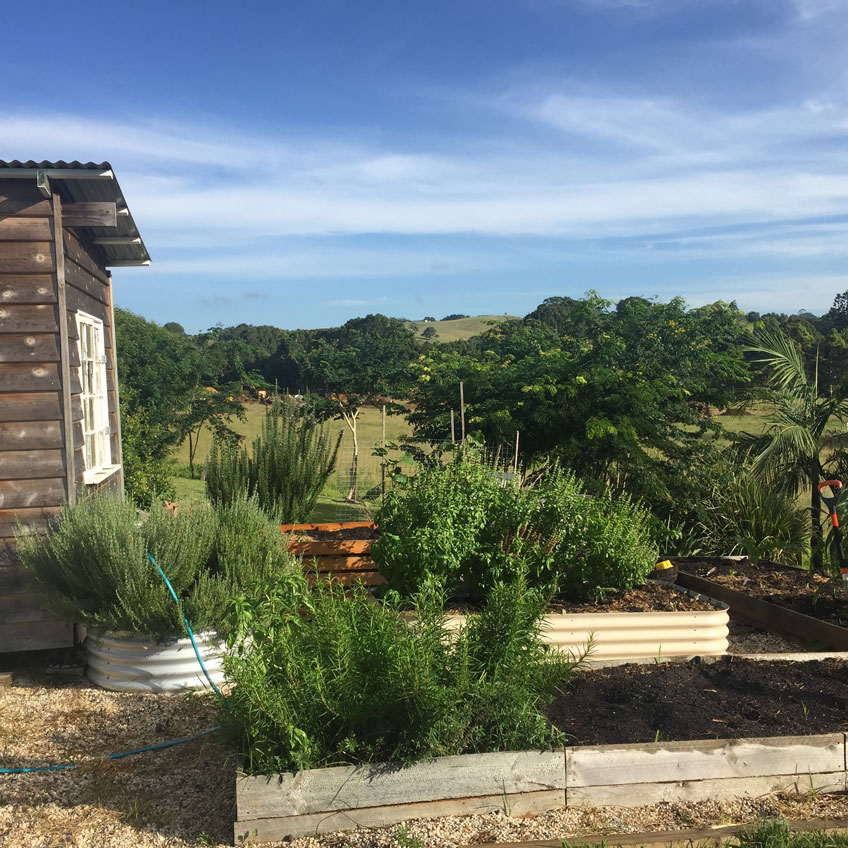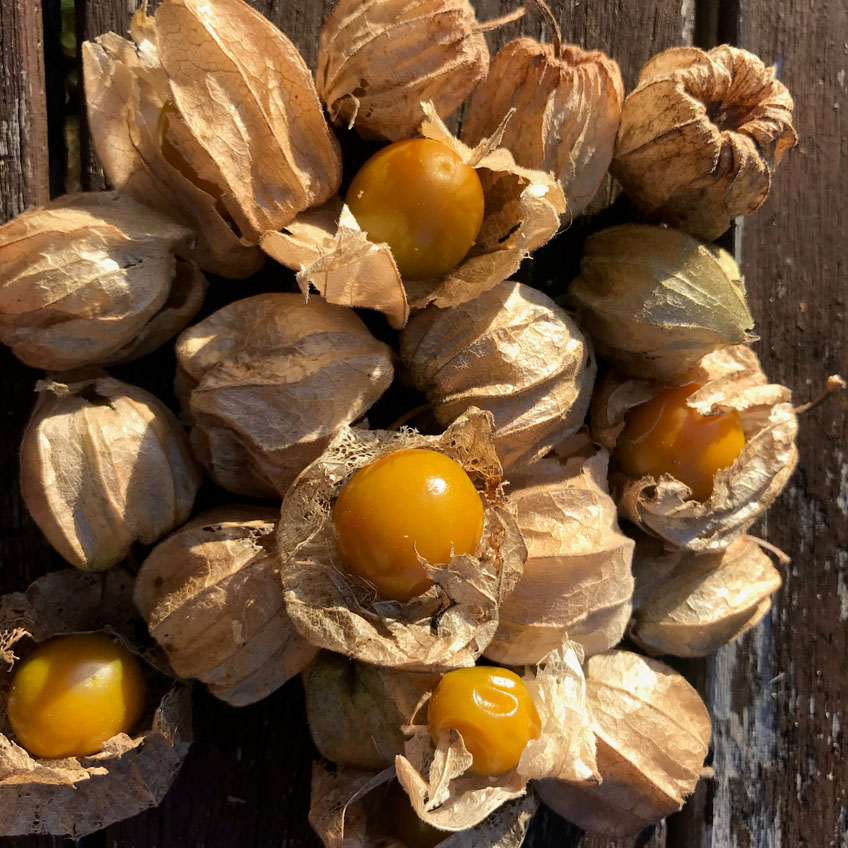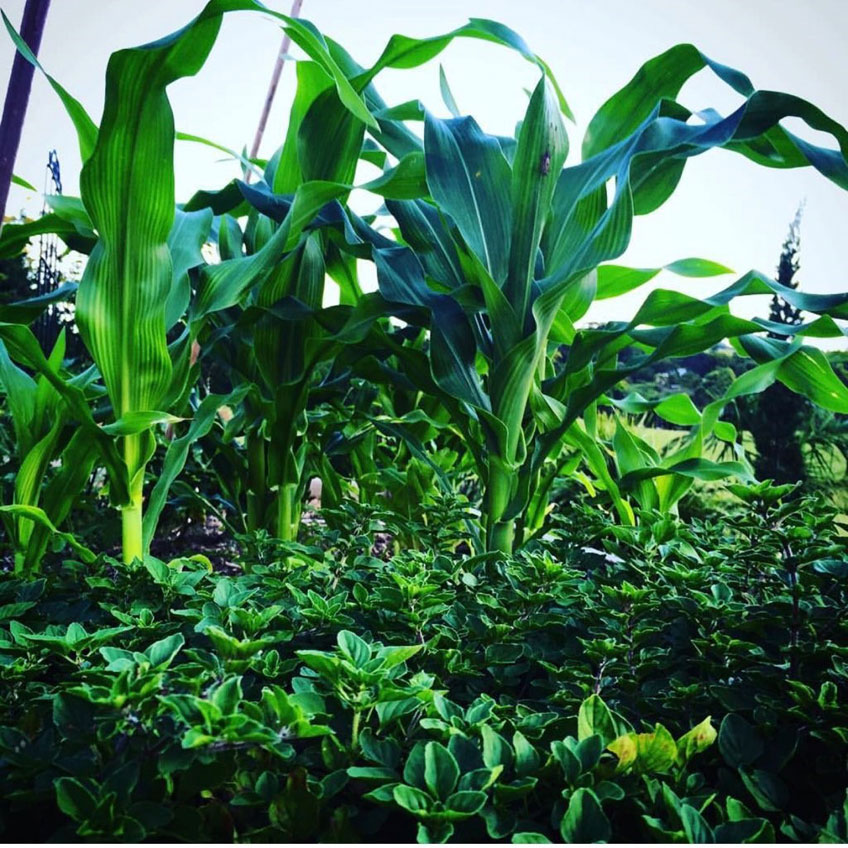In the first of a new series that shares the knowledge and experience of food growers around the country, Kate Neale dishes the dirt on her top summer growing tips and her favourite new harvest.
Words and pictures: Kate Neale

Kate Neale's summer vegie patch.
Meet Kate
We first met Kate when we came across her work developing educational and therapeutic horticulture programs for childcare centres, schools, social housing,
aged care and disability services (you can find our interview about her KindyGarden program in the Winter 2017 issue of GC, or at www.gardenclinic.com.au.)
Kate takes her passion for gardening home to her vegie patch in Bangalow in northern NSW where she lives with husband, two children and three chickens.
Kate's vegetable patch is now at 21sq m and what’s left of the lawn would be threatened if she didn’t have a full-time job. She’s also a keen Instagrammer,
who you can follow at @mylittlesheshed. For summer Kate is our guest kitchen gardener, sharing the ins and outs of her season.

Phew! Hard work and rewards.
I’m loving cape gooseberries
I tasted a cape gooseberry for the first time in a friend's garden in late February 2016. The delicious pop of sweet flavour took me by surprise and I
was hooked. I’ve been hunting down the fruit ever since and finally, at the end of last summer, I found one little seedling in my local garden shop.
It came home with me immediately.
Cape gooseberries are related to tomatillos and are originally from Peru. They are generally grown as annuals in cool climates, and I must confess my new
prize didn’t appreciate the few frosts we had in late winter, though it survived the short spell of cold and started thriving again soon after.
Summer is here and my little plant is now a beautiful half-metre-high bush (fully grown Cape gooseberries can form a bush about a metre and half tall)
with translucent lanterns providing glimpses of fruit ripening by the day. My typically neglectful style of gardening has paid dividends with this
plant - it likes harsh conditions including hot sun, little watering and somewhat poor quality (slightly acidic) soil. I’ve read that mildew can be
an issue, so I’ll be mindful of hot humid days and ensure the leaves don’t get too wet.
I’ve discovered that the best fruit to eat are those fallen on the ground (which remain edible for days after they have fallen). The soft, burnt-orange
flesh is the best indication of sweet flavours and finding one with withered skin almost guarantees a jammy delight. Cape gooseberries can be cooked
in dishes savoury and sweet and used in jams and drinks. So far though all the fruits from my young little plant have been devoured right there in
my garden, though I look forward to an abundance of fruit as my plant matures over the next few years.

Cape Gooseberries
I’m shading my greens
A great tip for protecting soft leafy greens from the harsh summer sun is to plant them under the canopy of taller, sun-loving crops. I’ve been most successful
planting under and in between corn. I’d like to claim this idea as a stroke of gardening genius on my part, but it came about through reckless overstuffing
of my garden beds. But by chance I’ve happened upon a great way to protect soft leafy greens like herbs and salad leaves from the harsh summer sun,
preventing them from tasting bitter, feeling tough to the bite, and also from bolting too early. The other benefit of this temporary canopy is that
once late-summer’s cooler days arrive, the corn is harvested and the herbs and lettuce can go back to enjoying full sun without the need to be moved
or replanted elsewhere.
I plant both the corn and salad leaf or herb seedlings at the same time to give ample sunlight to both as they establish their roots. Then, as the corn
takes over and grows taller, the leaves of the more mature lettuce or herbs are protected from the harsh heat of the day, while still enjoying dappled
sunlight thanks to the slim and tall profile of the corn.
If you decide to try this with herbs, I’ve found this system is most successful with coriander and chives. Although I don’t personally like parsley so
don’t grow it, I’m sure it would also enjoy the reprieve from hot days. Basil and dill like the sun, but still grow in the corn-shade, though less
rampantly than in full sun. My misbehaving and ever-creeping oregano has also enjoyed its time under the canopy of corn too, though I think the safest
place for it is in a pot. Likewise mint – the worst culprit of the garden bed takeover!

Corn and Oregano
My summer to-do
Plant repeat crops weeks apart. Hot days often cause lettuce and herbs to bolt, so it’s always good to have new plants coming through.
Optimistically expecting Indian summers, I always plant crops of corn, cucumber and tomato right through until late February to extend my summer harvest
into early April.
Leave shallow water vessels out for bees and other beneficial insects to help them through hot spells. I place them in garden beds so they catch incidental
watering and are shaded to slow evaporation.
Water strawberries well when the fruit appears for delicious big fruit. Wait until they are fully coloured before eating to maximise flavour and sweetness
- and as this makes them equally irresistible to birds, insects and lizards, I cover mine with a canopy.
Continue to fertilise your citrus through summer and keep the plants well mulched under the dripline (basically the ground under the tree’s canopy). I’m
a massive fan of RichGro Black Marvel citrus food. I’ve learnt that citrus is particular about the dripline staying free of competition so regular
weeding and keeping the grass back is important. In summer, this really needs regular attention.
Grow lots of cherry tomatoes for quick wins and salad staples in case your larger heirloom varieties fail. To minimise risk of disease, always water tomatoes
at ground level and discard any diseased leaves immediately.
Regularly water and feed chillies to ensure continued summer growth and a long season of fruit. I water at least three times a week in summer, especially
once flowers appear and fruit is setting. I pick them regularly to promote new growth and a constant supply right through to late autumn.
Thanks to my friends on Instagram, from whom I have learned much of this knowledge.